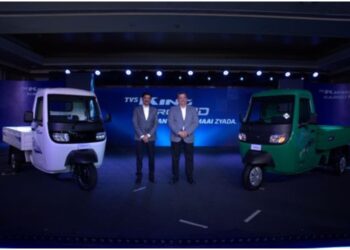- With 250 million electric vehicles (EVs) on the world’s roads by 2030, fires involving EVs will increase – unless battery cell technologies become inherently safer
- While much less frequent than those involving ICE vehicles, EV fires are more dangerous, and more likely to occur when the vehicle is parked or during charging
- Increasing cell energy densities have raised the risk by increasing the combustible material inside batteries
- EV battery fire-related recalls can cost in the region of $1 billion per vehicle model line with multiple car makers already experiencing expensive recalls over the last five years
- 24M believes that EV batteries represent a severity 10 rating, the most severe level within the automotive industry’s established DFMEA risk evaluation process, requiring fundamental design changes, not just manufacturing process controls
- The auto industry must reimagine cell design to incorporate safety as a foundational element, preventing fires caused by short circuits within the battery cell
- Unlike existing battery fire containment systems, 24M’s Impervio separator technology stops thermal runaways inside cells before they start, addressing the core problem
- Impervio also monitors cell health and enables targeted recalls of specific, affected vehicles rather than entire model lines, potentially saving car makers billions
London : 24M Technologies warns that as the number of electric vehicles (EVs) worldwide and cell energy densities grow dramatically, thermal incidents are set to increase, with a significant potential impact on public safety and OEM profitability, unless battery cell design is reimagined.
The total number of EVs on the world’s roads is forecast to reach 250 million in 2030, up from around 40 million vehicles today, and with some markets already experiencing a 33%2 increase in thermal incidents involving EVs, the problem is only going to increase. While these are far less frequent than fires involving ICE cars, they still pose major safety concerns as they are much more dangerous, and more likely to take place when a vehicle is parked or during charging. Even at a conservative rate of one fire per 10,000 EVs, thermal incidents could reach 25,000 per year worldwide by the end of the decade.
In addition to EV volume growth, cell energy density is another factor that affects battery safety. Energy density has been continuously increasing over time, providing longer ranges and enabling greater EV adoption, thanks to energy richer materials and smaller cell component safety margins. But despite manufacturers’ best efforts, process failures, particularly contamination risks, cannot be completely avoided. These issues, as well as the growth in ever faster charging capabilities, increases the threat of internal short circuits, which cannot be stopped externally.
With recalls related to EV fires carrying an estimated price tag of $1 billion per vehicle3 model line, cell design must be reimagined to be fundamentally safer. Although systems exist to contain a fire once it has started, 24M believes EV fires can be prevented in the first place by properly addressing and preventing root causes. If this does not take place, car makers may face significant extra costs in coming years, alongside increased risks to public safety.
Naoki Ota, President and CEO at 24M Technologies said: “The industry’s current safety challenges stem from decades-old battery design principles. While we’ve achieved remarkable progress in cost reduction and energy density, we’re still building upon architectures that have not fundamentally changed in more than 30 years. Process improvements alone cannot address these design limitations and multiple OEMs have faced costly recalls as a result. Rather than address these issues through add-on system features, safety must be incorporated as a foundational element at the core of the battery cell.”
Among potential risks within an automobile, battery safety and health need to be paramount. The automotive industry today utilizes the established Design Failure Mode and Effects Analysis (DFMEA) process to identify critical risks, where the highest rating of 10 has the potential of a serious, adverse effect on consumer safety, including catastrophic damage, major system failure, life-threatening injury or death. When a DFMEA rating is assigned a severity rating of 9 or 10, only a design change can mitigate the risk and reduce its severity. 24M believes batteries and their inherent safety concerns should be treated as a severity 10 rating, like steering system pressure, anti-lock brake defects and airbag malfunctions.
Fires in lithium batteries often occur because of dendrite growth in cells. Dendrites are inevitable over a battery’s lifecycle as it ages and undergoes thousands of charge/discharge cycles. They can also occur through overcharging, charging at very low temperatures or frequent fast charging/discharging. This can create a short circuit or ‘thermal runaway’ where the cell overheats, releasing flammable gases which then ignite. It only takes one cell to overheat, which can happen in milliseconds. Once an event begins, it is impossible to stop without intervention and it risks propagating to adjacent cells, the battery and ultimately the vehicle.
Naoki Ota, President and CEO at 24M Technologies, continued: “The solution is to incorporate transformative in-cell fire prevention technology. 24M’s pioneering Impervio system is uniquely capable of suppressing dendrites and neutralising thermal runaway before it can start. Unlike other technologies, Impervio not only monitors individual cells but prevents thermal incidents. The industry must shift from reactive measures to try to contain fires to proactive designs preventing failures before they occur. Without this step change approach, the safety and financial challenges will only intensify as EV adoption accelerates.”
Although EVs are 20 times less likely to catch fire than ICE vehicles, they pose a greater risk when parked or when charging in public and private garages, apartment blocks, shopping centres and other buildings. Fires involving EVs are harder to extinguish, sustained by internal chemical reactions which can reach extreme temperatures. Traditional firefighting methods can prove ineffective as the fires can reignite hours or even days and weeks later, due to residual energy in undamaged cells, requiring specialised equipment and prolonged cooling periods.
Ulrik Grape, President, European Operations, at 24M Technologies said: “Impervio offers a proactive solution for the world’s car makers, fundamentally changing how battery safety is approached through revolutionary new battery cell design. Controlling the cell at the individual electrode level, the Impervio separator actively suppresses dendrite growth within cells while enabling sophisticated monitoring capabilities for early fault and short-circuit detection. It can shut down a cell that is at risk – monitoring, preventing, containing – and represents a step change in safety while offering the capability to massively reduce risk and financial exposure.”
As an example, in a side-by-side test of two NMC/graphite cells, one with Impervio, the other with a conventional separator, charged to 100%, then to 100% overcapacity, non-Impervio cells saw dendrite growth-induced micro shorts after 15 minutes, with the cell forming a hard short, catching fire and then exploding after 38 minutes. However, cells with 24M’s Impervio technology saw negligible temperature increase, did not short and did not catch fire – even after an entire hour of overcharging.
Integrating seamlessly with conventional lithium-ion, lithium metal, and 24M’s proprietary LiForever cells, and providing continuous cell monitoring, Impervio enables OEMs to identify and address potential issues before they escalate into safety hazards. It also allows OEMs to target recalls to specific affected units rather than recalling an entire model line, potentially saving billions in recalls, while maintaining optimal safety standards. In addition, Impervio can improve battery state-of-health (SOH) and end-of-life (EOL) predictions, influencing overall battery life and potential reuse.
Impervio is available today and 24M Technologies is actively collaborating with several industry partners and leading car makers to integrate this technology into next-generation battery designs. These innovations offer manufacturers a quick path forward to enhance safety and maintain performance standards essential for widespread EV adoption.













